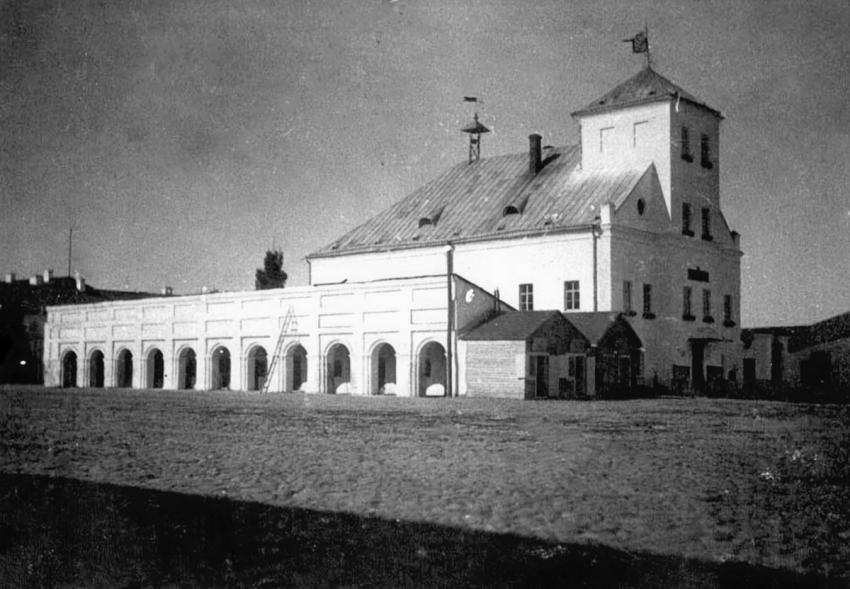When World War II broke out, some 3,400 Jews lived in Nieśwież – close to half the local population. Most made a living as traders and craftsmen. Zionist political parties and youth movements were active in the town, as well as “Agudat Yisrael” and the Bund, and there were also Jews in the outlawed Polish Communist party. There were two schools, a “Tarbut” school and a Yiddish school.

Municipality building in Nieśwież, in front of which thousands of Jews were gathered prior to their execution
Yad Vashem Photo Archives 52FO4
ZIH - Zydowski Instytut Historyczny, Warszawa, Poland
Soviet Occupation
In September 1939, with the Soviet invasion of Eastern Poland, the Soviets occupied Nieśwież, and the city was annexed to the Byelorussian Soviet Socialist Republic. At the same time, Jewish refugees from occupied Poland started to stream into Nieśwież. The Soviets nationalized the city’s economy, dismantled Jewish institutions and organizations, and effectively put an end to Jewish political life. The two Jewish schools were merged, and in the newly merged school, Yiddish was the language of instruction and a Soviet curriculum was instituted. In the second year of the Soviet regime in the city, Russian replaced Yiddish as the language of instruction at the school.
German Occupation and Murder of the Majority of the City’s Jews
With the German invasion of the Soviet Union on 22 June 1941, a few Jews fled from Nieśwież to the Soviet Union with the retreating Soviet Army. On the eve of the German occupation in June 1941, some 4,600 Jews lived in the city.
On 27 June 1941 the Germans occupied Nieśwież, and within a few days, anti-Jewish measures were enacted. Early measures included the obligation to wear the Yellow Star, the prohibition on walking on sidewalks, the prohibition on relations with non-Jews, and recruitment to forced labor. The Germans instituted a Judenrat and appointed a Jewish lawyer from Warsaw who had taken refuge in Nieśwież as its head.
In October, the Germans ordered the Jews of Nieśwież to pay a ransom in rubles and gold. In order to ensure the ransom’s payment, the Germans took local Jewish men as hostages. Abuse, robbery and murder of Jews became an everyday occurrence. The Jews’ silver and copper was confiscated, residents of the main streets were evicted from their homes, and every infraction of a German order was punishable by death. A number of Jews were charged with buying potatoes from peasants, and were subsequently murdered.
On 29 October 1941, the Judenrat was ordered to gather all the Jews in the market square. The following day, after hours of waiting in the square, 685 professionals and their families were separated from the others. The remaining Jews, some 4,000 men, women and children, were taken to pits that had been prepared in advanced in the Nieśwież palace garden, and to pits that had been dug about 3 km away from the city, on the way to Snow. The Jews were forced to undress, and were shot to death into the pits. The murderers were members of a Lithuanian murder squad, German gendarmes and members of Einsatzkommando 8.
